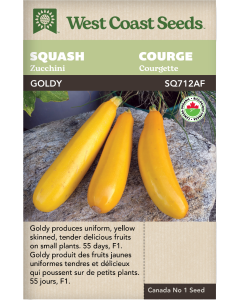Be the first to review this product
PRODUCT DETAILS
Salad Bowl lettuce seeds are a traditional stand-by for salad mixes. These large, lime-green rosettes resist bolting for a long time in summer and do not get bitter. The frilly, deeply cut oakleaf shape has excellent flavour and good texture. They add loft and character to salad mixes. Rapid cool-weather growth makes it a prime candidate for spring cold frame growing. This heirloom lettuce dates back to 1952, the year it was given a well deserved AAS Award. It's also a winner of the RHS Award of Garden Merit. Give it a try in patio containers to keep near the kitchen. The individual leaves are a nice addition to sandwiches, or just as garnishes.
Matures in 60 days. (Open-pollinated seeds)
- Looseleaf
- Frilly, deeply cut oakleaf shape with excellent flavour
- Heirloom dating back to 1952
- Open pollinated seeds
- Matures in 60 days
All About Salad Bowl
Latin
Lactuca sativa
Family: Asteraceae
Difficulty
Easy
Season & Zone
Season: Cool season
Exposure: Full sun to partial shade
Timing
Lettuce grows best in cool weather in the spring and fall, but it can be grown in the summer, and all winter long in milder regions. Sow short rows every 2-3 weeks following the last average frost date for a continual harvest. Using a cloche, cold frame, or greenhouse over mid-late summer plantings can extend the harvest period right into winter. Optimal soil temperature for germination: 10-22°C (50-72°F). Seeds should sprout in 7-15 days, depending on conditions. Lettuce seeds don’t sprout easily when the soil temperature is over 22°C (72°F) in summer. Get around this by sprouting them indoors in a cool area, or pre-sprout by sprinkling seeds on a damp paper towel and placing it in a plastic bag in the fridge for a few days. In hot weather most lettuce goes to seed rapidly, so have new plantings ready to go, and watch for "good resistance to bolting" in the product description.
Starting
Direct sow or start indoors and transplant. Sow seeds 5mm (¼”) deep, or on the surface of the soil where the soil can be kept evenly moist.. Space or thin heading lettuce to 30cm (12″) apart. Space or thin looseleaf varieties to 20-25cm (8-10″) apart. Space rows for all types 45-90cm (18-36″) apart. Babyleaf lettuce can be planted quite densely, as it is harvested at an immature size. Sowing babyleaf lettuce seeds closely together in narrow rows makes harvesting simpler.
Note on Pelleted Seeds: A number of our lettuce seeds are pelleted for machine planting. The white clay ball that covers each seed makes them easier to handle and easier to see when planted. While most lettuce seeds need to be barely covered (or sown on the surface of the soil), pelleted seeds need to be buried by about 1cm (1/2″). Please keep your newly sown pelleted seeds evenly moist – use more water than with conventional seeds. If the soil is allowed to dry out, the clay pelleting material can wick water away from the seed, causing uneven or lower germination.
Days to Maturity:
From direct sowing. Most varieties will be ready for harvesting as baby leaves in half the days shown on the packet.
Growing
Ideal pH: 6.0-6.5. Aim for a soil with ample drainage and lots of organic matter. Add compost and lime at least 3 weeks prior to planting. One cup of balanced organic fertilizer per 3m (10′) of row will give adequate nutrition. Seedlings should be hardened off by reducing water and putting the plants outdoors 2 or 3 days before transplanting. This will help to prevent transplant shock and premature bolting. Regular watering is essential to prevent leaves from developing a bitter taste.
Harvest
Pick individual leaves or wait and harvest full heads. Mature summer lettuce stays in prime eating condition only a short time, so harvest promptly and keep planting. In fall and winter the plants stay in good harvest condition longer.
Seed Info
In optimal growing conditions at least 70% of seeds will germinate. Usual seed life: 3 years. Per 100′ row: 240 seeds head lettuce/1.2M seeds leaf type, per acre: 58M seeds head lettuce/348M leaf type.
Diseases & Pests
Crop rotation is important for disease prevention. Tip burn (tips of leaves turning brown) is caused by a calcium deficiency. If you have limed, tip burn can be caused by nutrient imbalances or lack of moisture. Slugs are a problem in early and late plantings, so clean up their hiding places, and only water in the morning.
Companion Planting
Lettuce plants make good companions for beets, Brassicas, carrot, celery, chervil, cucumbers, dill, garlic, onions, radish, spinach, squash, and strawberries.
| Manufacturer's Model Number | LT460AF |
|---|---|
| UPC | 687704071248 |
| Brand | West Coast Seeds |
| Family | Lettuce |
| Group | Loose-leaf |
| Days to Maturity | 60 |
| Certified Organic | No |
| Heirloom | No |
| Open Pollinated | Yes |
| Hybrid | No |
| Shipping Type | Seeds |














Login and Registration Form